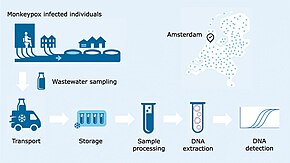
Wastewater surveillance is the process of monitoring wastewater for contaminants. Amongst other uses, it can be used for biosurveillance, to detect the presence of pathogens in local populations,[1] and to detect the presence of psychoactive drugs.[2]
One example of this is the use of wastewater monitoring to detect the presence of the SARS-CoV-2 virus in populations during the COVID-19 pandemic.[3][4][5] In one study, wastewater surveillance showed signs of SARS-CoV-2 RNA before any cases were detected in the local population.[6]
Later in the pandemic, wastewater surveillance was demonstrated to be one technique to detect SARS-CoV-2 variants[7] and to monitor their prevalence over time.[8][9] Comparison between case based epidemiological records and deep-sequenced wastewater samples validated that the composition of the virus population in the wastewater is in strong agreement with the virus variants circulating in the infected population.[10] Following the 2022-23 reopening surge of COVID-19 cases in China, airplane wastewater surveillance began to be employed as a less intrusive method of monitoring for potential variants of concern arising within specific countries and regions.[11]
At the request of the US Centers for Disease Control, the National Academies of Sciences, Engineering, and Medicine revealed, in a January 2023 report, its vision for a national wastewater surveillance system. Such a system would, according to the report committee, remove geographical inequities in the identification of future SARS-CoV-2 variants, influenza strains, antibiotic resistant bacteria, and other potential threats. Nationwide wastewater surveillance would likewise be combined with wastewater collection at other early-warning "sentinel sites," such as zoos and international airports.[12]
The European Union identified wastewater surveillance as “a cost effective, rapid and reliable source of information on the spread of SARS-CoV-2 in the population and that it can form a valuable part of an increased genomic and epidemiological surveillance”[13] and proposes to extend the urban wastewater surveillance to poliovirus, influenza, emerging pathogens, contaminants of emerging concern, antimicrobial resistance and any other public health parameters that are considered relevant by the Member States.[14]
- ^ Sinclair, Ryan G.; Choi, Christopher Y.; Riley, Mark R.; Gerba, Charles P. (2008). "Pathogen Surveillance Through Monitoring of Sewer Systems". Advances in Applied Microbiology. 65: 249–269. doi:10.1016/S0065-2164(08)00609-6. ISBN 9780123744296. ISSN 0065-2164. PMC 7112011. PMID 19026868.
- ^ Sulej-Suchomska, Anna Maria; Klupczynska, Agnieszka; Dereziński, Paweł; Matysiak, Jan; Przybyłowski, Piotr; Kokot, Zenon J. (2020-03-17). "Urban wastewater analysis as an effective tool for monitoring illegal drugs, including new psychoactive substances, in the Eastern European region". Scientific Reports. 10 (1): 4885. Bibcode:2020NatSR..10.4885S. doi:10.1038/s41598-020-61628-5. ISSN 2045-2322. PMC 7078280. PMID 32184422.
- ^ "These Scientists Are Sewer-Diving in an Attempt to Detect Silent COVID-19 Outbreaks". Time. 2 August 2020. Retrieved 2020-08-04.
- ^ Daughton, Christian G. (2020-09-20). "Wastewater surveillance for population-wide Covid-19: The present and future". Science of the Total Environment. 736: 139631. Bibcode:2020ScTEn.73639631D. doi:10.1016/j.scitotenv.2020.139631. ISSN 0048-9697. PMC 7245244. PMID 32474280.
- ^ [email protected] (2020-05-21). "A NIST-Hosted Webinar on Measuring SARS-CoV-2 in Wastewater and Fecal Material: A Call for Standards". NIST. Retrieved 2020-08-04.
- ^ Randazzo, Walter; Truchado, Pilar; Cuevas-Ferrando, Enric; Simón, Pedro; Allende, Ana; Sánchez, Gloria (2020-08-15). "SARS-CoV-2 RNA in wastewater anticipated COVID-19 occurrence in a low prevalence area". Water Research. 181: 115942. Bibcode:2020WatRe.18115942R. doi:10.1016/j.watres.2020.115942. ISSN 0043-1354. PMC 7229723. PMID 32425251.
- ^ Smyth, Davida S.; Trujillo, Monica; Gregory, Devon A.; Cheung, Kristen; Gao, Anna; Graham, Maddie; Guan, Yue; Guldenpfennig, Caitlyn; Hoxie, Irene; Kannoly, Sherin; Kubota, Nanami; Lyddon, Terri D.; Markman, Michelle; Rushford, Clayton; San, Kaung Myat; Sompanya, Geena; Spagnolo, Fabrizio; Suarez, Reinier; Teixeiro, Emma; Daniels, Mark; Johnson, Marc C.; Dennehy, John J. (3 February 2022). "Tracking cryptic SARS-CoV-2 lineages detected in NYC wastewater". Nature Communications. 13 (1): 635. Bibcode:2022NatCo..13..635S. doi:10.1038/s41467-022-28246-3. ISSN 2041-1723. PMC 8813986. PMID 35115523.
- ^ Amman, Fabian; Markt, Rudolf; Endler, Lukas; Hupfauf, Sebastian; Agerer, Benedikt; Schedl, Anna; Richter, Lukas; Zechmeister, Melanie; Bicher, Martin; Heiler, Georg; Triska, Petr; Thornton, Matthew; Penz, Thomas; Senekowitsch, Martin; Laine, Jan (2022). "Viral variant-resolved wastewater surveillance of SARS-CoV-2 at national scale". Nat Biotechnol. 40 (12): 1814–1822. doi:10.1038/s41587-022-01387-y. PMID 35851376. S2CID 250642091.
- ^ Bartel, Alexander; Grau, José Horacio; Bitzegeio, Julia; Werber, Dirk; Linzner, Nico; Schumacher, Vera; Garske, Sonja; Liere, Karsten; Hackenbeck, Thomas; Rupp, Sofia Isabell; Sagebiel, Daniel; Böckelmann, Uta; Meixner, Martin (2024-01-10). "Timely Monitoring of SARS-CoV-2 RNA Fragments in Wastewater Shows the Emergence of JN.1 (BA.2.86.1.1, Clade 23I) in Berlin, Germany". Viruses. 16 (1): 102. doi:10.3390/v16010102. ISSN 1999-4915. PMC 10818819. PMID 38257802.
- ^ Galani, Aikaterini; Aalizadeh, Reza; Kostakis, Marios; Markou, Athina; Alygizakis, Nikiforos; Lytras, Theodore; Adamopoulos, Panagiotis G.; Peccia, Jordan; Thompson, David C.; Kontou, Aikaterini; Karagiannidis, Apostolos; Lianidou, Evi S.; Avgeris, Margaritis; Paraskevis, Dimitrios; Tsiodras, Sotirios; Scorilas, Andreas; Vasiliou, Vasilis; Dimopoulos, Meletios-Athanasios; Thomaidis, Nikolaos S. (January 2022). "SARS-CoV-2 wastewater surveillance data can predict hospitalizations and ICU admissions". Science of the Total Environment. 804: 150151. Bibcode:2022ScTEn.80450151G. doi:10.1016/j.scitotenv.2021.150151. PMC 8421077. PMID 34623953.
- ^ Howard, Jacqueline; Atwood, Kylie; Muntean, Pete (5 January 2023). "CDC has tested wastewater from aircraft amid concerns over Covid-19 surge in China". CNN. Archived from the original on 5 January 2023. Retrieved 6 January 2023.
- ^ Anthes, Emily (19 January 2023). "A New Report Outlines a Vision for National Wastewater Surveillance". New York Times. Archived from the original on 20 January 2023. Retrieved 20 January 2023.
- ^ "Commission Recommendation (EU) 2021/472 of 17 March 2021 on a Common Approach to Establish a Systematic Surveillance of SARS-CoV-2 and Its Variants in Wastewaters in the EU". European Parliament and Council. 17 March 2021.
- ^ "Proposal for a DIRECTIVE OF THE EUROPEAN PARLIAMENT AND OF THE COUNCIL concerning urban wastewater treatment (recast)". European Parliament and Council. 26 October 2022.